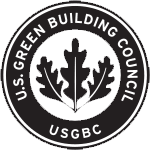As with many workspace remodels, one of the concerns we addressed was the noisiness of our space and how to implement acoustic solutions to help.
Oh, the tranquil, calming noises of the office environment. A copier rifling off papers. The coffee maker humming. Your deskmate chewing loudly. A phone ringing endlessly for all eternity. While we currently live in a strange time within the current pandemic that actually brings up some nostalgia for these background office sounds (…to the point where people are creating interactive websites that recreate this white noise for you while you are stuck working at home), under normal circumstances these sounds can make the workplace incredibly distracting and unproductive.
We often hear from our customers about how managing noise levels in their workspace is a top priority, and they are right to be concerned with this. After researching the effects of noise on workers in the 1970s, the EPA noted that, “Excessive noise exposure can bring about a wide variety of psychological responses or symptoms…such as anxiety, irritability, and/or general emotional stress. Noise may negatively affect work performance because of reduced worker morale and motivation. Distraction and poor judgment may result from mental fatigue.”
As we set off on our showroom remodel, incorporating acoustic solutions throughout our space was a priority, as we have recently become 3form’s authorized dealer in Idaho. Here are some things that we thought about as we considered the acoustic performance of our workspace.
The Basics of Acoustic Design
The field of architectural acoustics has become increasingly more scientific and research-based in recent decades, so a request from a customer to make a space “less noisy” isn’t always as simple as it sounds. When considering how to enhance the acoustics of a space, we must think about both the performance of a product and also how much coverage is necessary.
To measure performance of acoustical materials, two metrics are typically used:
Sound Transmission Class (STC)
: a single number quantifier of how effective a product is in blocking sound
: how well a product keeps sound from escaping the room
: the higher the STC, the more effective the partition
Noise Reduction Coefficient (NRC)
: an average rating of how much sound an acoustic product can absorb.
: how well a product makes the room you are in quieter
: the higher the NRC, the more effective the product
While most acoustical products have value as measured by both STC and NRC, we will stick with referencing NRC moving forward as this is the measurement that 3form most commonly uses to rate their products.
As a point of reference, painted drywall wall has NRC of about .05, so it absorbs only about 5% of the sound that hits it and reflects back 95% of the sound. At a NRC of 1, 100% of the sound is being absorbed by the product and no sound is reflected back into the room.

.05 NRC = very little sound absorption (the sound absorption of painted drywall) – 95% of the sound bounces off of the wall and back into the room, as shown by the red waves.

.5 NRC = 50% of the sound is absorbed by the acoustical product while 50% of the sound is being reflected back into the room.

1 NRC = 100% of the sound is being absorbed by the acoustical product while no sound is being reflected back into the room.
While performance of a product is objectively measurable, there is no scientific formula for how much coverage of acoustics should be used in a space. If you are looking at a school gymnasium, for example, putting up one fabric panel won’t do anything. Conversely, covering every inch of the walls and ceilings in fabric panels will completely kill the sound. The ideal acoustical treatment for a room or a space will fall somewhere between these two extremes, and we recommend leaning on common sense, preference, and design aesthetic for making that determination.
When to Consider Incorporating Acoustic Products
One of the things we learned through our showroom model is that the best time to start thinking about incorporating acoustical products in your space was…yesterday. “In the past, acoustic design was often an afterthought; a corrective action that is brought in to fix whatever acoustic problems arose during the normal design process. We’re starting to realize that the way that we design the geometry and the way that we choose the materials of the space can be part of a more holistic solution.” This observation comes from the following video by 3form:
Many workspaces don’t address acoustical pitfalls on the front end of the design process and then are forced to backtrack to solve issues that are only revealed after move-in day. While it is more than possible to add acoustical products after employees move in, bad acoustics can create issues early on during occupancy, causing employees to have a bad first impression of the new or remodeled work environment. As an example, an unintended consequence of bad acoustics might be employees wearing noise cancelling headphones during the work day, thereby limiting their interaction and collaboration with other employees (ironically, hindering the very things the new workspace design was attempting to enhance in the first place).
Where to Consider Incorporating Acoustic Products
From past experience and feedback from customers, we have found that the biggest problem areas for acoustics include places where privacy and concentration are most important. These areas include manager’s offices, quiet rooms, conference rooms, breakout or social spaces, and busy reception areas. We often hear concern about noise levels in open office areas as well, where low-height workstation partitions are the only thing that separate employees from one another.
“Acoustics matter in every space.”
– Zackery Belanger, Acoustics Expert, Arcgeometer
For every space, application of acoustic solutions should be tailored to the intent and needs of that given space. While noise can be mitigated to a certain extent everywhere within an office, it is important to remember that sound ultimately travels like water; it will move through space in whatever direction it is able to. This truth makes it more difficult to create acoustical privacy in areas like open workstations.
How We Incorporated Acoustic Products in Our Showroom
While you can incorporate acoustic properties into almost any product in a space, you most typically see the following:

Partitions
Including panels and screens.

Wall Features
Including panels, tiles, and blocks.

Ceiling Features
Including baffles and clouds.

Furniture
Including partitions, screens, and panels.
Within our showroom, we focused on adding these acoustical products in some areas that we deemed as potential pitfalls for noisiness. Here’s what we added:
Links to the products featured above: 3form Divy Baffles, 3form Clario Cloud Squares, 3form Hush Clad, 3form Divy Partition, 3form Seeyond Wall Feature, 3form Clario Cloud, Haworth Openest, Haworth Cabana Lounge, Green Furniture Concept Leaf Lamps
We believe the best way to select acoustic products for your office is to start with how a space needs to function, and then lean on common sense, preference, and design aesthetic. The question should move away from whether you need a NRC of .5 or 1 and toward how your people will function in a space and how to maximize their wellbeing while they are in it. If you need help with this, we are here and would love to talk more about the acoustical performance of your workspace.






























